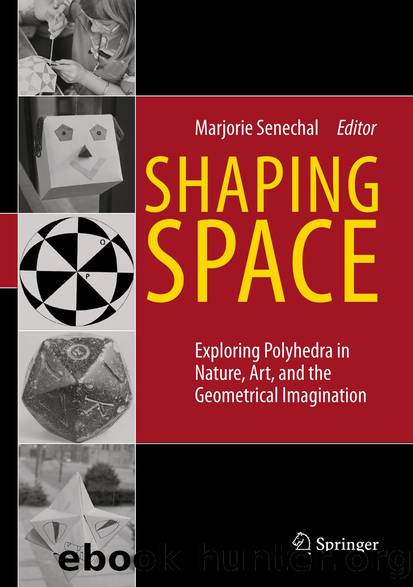Shaping Space by Marjorie Senechal

Author:Marjorie Senechal
Language: eng
Format: epub
Publisher: Springer New York, New York, NY
Polyhedral Themes
In addition to the variety of motivations for studying polyhedra theory, several themes run throughout the following papers and problems.
Symmetry. The aesthetic link between symmetry, beauty, and perfection was undoubtedly the reason why the regular polyhedra were first noticed and singled out for attention millennia ago. A great deal has already been said about symmetry in this book, so we will not review the basic concepts here. The following remarks, however, may be helpful to keep in mind while reading the following chapters.
Symmetry theory is not a museum piece, but a valuable tool in the study of polyhedra. We have just seen that symmetry often suggests interesting generalizations. It can also be a guide in searching for new kinds of polyhedra. The semiregular polyhedra discovered by Archimedes were (at that time) a new class of highly symmetrical polyhedra, and Archimedes probably used symmetry considerations to ensure that this would be so. In fact, the eleven that can be obtained from the Platonic “solids” by truncation are obtained by truncating symmetrically: first a vertex (or edge) of a solid is truncated in such a way that its contribution to the symmetry of the polyhedron is not destroyed, and then all the other vertices are truncated in exactly the same way. This ensures that the truncated polyhedron has all the symmetries of the original regular one.
A requirement of symmetry can also help us to restrict a problem to a reasonable size. Obviously all sorts of idiosyncratic constructions are admitted under Definition 2; we cannot hope to survey them all. By focusing on those that have some symmetry properties, however, we obtain a manageable class of objects. And because symmetry is a hierarchical concept, we can broaden our study later by omitting its restrictions one by one. Symmetry can help to organize and present complex information. Several contributors (see Chapters 3, 5, and 19) point out the effectiveness of symmetry arguments in characterizing the coordinates of certain polyhedra; in his short chapter Barry Monson points out an interesting connection between this problem and the theory of numbers. (Indeed, the theory of polyhedra has connections with, and implications for, almost every branch of mathematics.)
Symmetry theory can also be used to study properties of polyhedra that are inadequately characterized by their geometry. For example, we have seen that a carbon atom is often represented as a regular tetrahedron because it is 4-valent. But when an atom joins with other atoms in a molecule or crystal, its four bonds may no longer be equivalent. To incorporate this information into the geometry of the tetrahedron, we can color its vertices or faces in such a way that equivalence is properly indicated. This leads us to the concept of “color symmetry,” which has been extensively studied both for polyhedra and tessellations of the plane. The colored tilings of interlocking creatures designed by M. C. Escher are typical examples of patterns with color symmetry, but less orderly colorings are important too. Again we must decide what we want to wall in and what we want to wall out.
Download
This site does not store any files on its server. We only index and link to content provided by other sites. Please contact the content providers to delete copyright contents if any and email us, we'll remove relevant links or contents immediately.
| Applied | Geometry & Topology |
| History | Infinity |
| Mathematical Analysis | Matrices |
| Number Systems | Popular & Elementary |
| Pure Mathematics | Reference |
| Research | Study & Teaching |
| Transformations | Trigonometry |
Weapons of Math Destruction by Cathy O'Neil(5029)
Factfulness: Ten Reasons We're Wrong About the World – and Why Things Are Better Than You Think by Hans Rosling(4015)
Factfulness_Ten Reasons We're Wrong About the World_and Why Things Are Better Than You Think by Hans Rosling(2751)
Descartes' Error by Antonio Damasio(2728)
A Mind For Numbers: How to Excel at Math and Science (Even If You Flunked Algebra) by Barbara Oakley(2688)
TCP IP by Todd Lammle(2633)
Applied Predictive Modeling by Max Kuhn & Kjell Johnson(2474)
Fooled by Randomness: The Hidden Role of Chance in Life and in the Markets by Nassim Nicholas Taleb(2407)
The Book of Numbers by Peter Bentley(2400)
The Tyranny of Metrics by Jerry Z. Muller(2397)
The Great Unknown by Marcus du Sautoy(2179)
Once Upon an Algorithm by Martin Erwig(2141)
Easy Algebra Step-by-Step by Sandra Luna McCune(2110)
Practical Guide To Principal Component Methods in R (Multivariate Analysis Book 2) by Alboukadel Kassambara(2087)
Lady Luck by Kristen Ashley(2067)
Police Exams Prep 2018-2019 by Kaplan Test Prep(2028)
Linear Time-Invariant Systems, Behaviors and Modules by Ulrich Oberst & Martin Scheicher & Ingrid Scheicher(1980)
All Things Reconsidered by Bill Thompson III(1957)
Secrets of Creation, Volume 1: The Mystery of the Prime Numbers by Watkins Matthew(1858)
